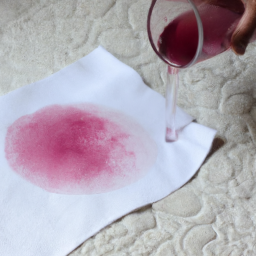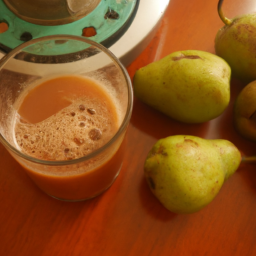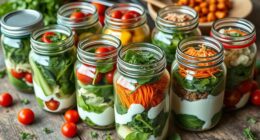As someone who loves experimenting with different flavors in the kitchen, I always keep a bottle of lemon juice in my fridge. However, sometimes I get busy with daily tasks and forget about it, only to realize later that it has expired. This leads me to wonder: how long is lemon juice good for after its expiration date?
The answer is not straightforward, as the shelf life of lemon juice depends on various factors such as the storage conditions, packaging, and the presence of preservatives. In this article, we will delve into the science behind the expiration dates on lemon juice bottles, the signs of spoilage to look out for, and ways to extend its shelf life. We will also explore whether it is safe to use expired lemon juice and alternative options for when you don’t have fresh lemon juice on hand.
So, let’s get started on our journey to unravel the mystery of the shelf life of lemon juice.
Key Takeaways
- Proper storage and packaging can extend the shelf life of lemon juice, but it depends on factors such as extraction method, juice purity, and storage conditions.
- Expiration dates should be taken into account, but they’re not always accurate. Signs of spoilage should also be checked, such as visual, olfactory, and gustatory indicators.
- Consuming expired lemon juice can pose health risks, including foodborne illnesses and chemical changes that alter flavor and decrease acidity.
- Proper handling and disposal of expired lemon juice is crucial to prevent harm to the environment. Composting can be a sustainable disposal method, and repurposing methods can reduce waste and promote sustainability.
Factors Affecting Shelf Life
So, if you’re wondering how long your expired lemon juice will last, it ultimately depends on several factors that affect its shelf life.
These factors include the method of extraction, the purity of the juice, and the conditions of storage.
When it comes to the method of extraction, freshly squeezed lemon juice tends to have a shorter shelf life compared to bottled lemon juice. This is because the latter undergoes pasteurization and has added preservatives that prolong its freshness.
The purity of the juice is also a crucial factor. If the lemon juice has impurities or has been exposed to contaminants, it can spoil faster. Therefore, it’s essential to ensure that the lemon juice is pure and has been extracted using clean equipment.
Proper storage conditions are also crucial in preserving freshness. Lemon juice should be stored in a cool, dry place, away from direct sunlight and heat.
With these factors in mind, it is possible to extend the shelf life of lemon juice beyond its expiration date. Understanding expiration dates is the next step in ensuring that your lemon juice is still safe to consume.
Understanding Expiration Dates
When it comes to understanding expiration dates, there are three key points to consider: what they mean, how they’re determined, and their limitations.
As someone who frequently checks expiration dates, it’s important to know what these dates actually represent. Additionally, understanding how these dates are determined can help you make informed decisions about when to use a product.
Finally, it’s important to recognize that expiration dates have limitations and should be used in conjunction with other factors when deciding whether a product is still safe to consume.
What They Mean
Understanding the meaning of expiration dates is essential to know how long lemon juice can stay good. Here are three things to keep in mind:
- Expiration dates indicate the date until which the product can be safely consumed or used.
- Expiration dates are determined based on various factors such as the ingredients used, processing methods, and packaging.
- Consuming expired lemon juice can lead to food poisoning, so it’s important to discard it once it reaches its expiration date.
As for how long lemon juice can stay good after its expiration date, it varies depending on the storage conditions and the degree of spoilage.
In the next section, we’ll delve deeper into how expiration dates are determined for lemon juice.
How They’re Determined
Determining the freshness and safety of expired lemon juice is not a straightforward process. When determining expiration guidelines, many factors come into play.
One of the most crucial factors is the acidity level of the lemon juice. Acidity acts as a natural preservative, which means that the higher the acidity, the longer the lemon juice will last.
Additionally, the type of packaging and preservatives used in the lemon juice also play a vital role in determining its shelf life. However, even with all these factors taken into account, there are limitations to how accurate expiration dates can be.
Factors such as storage conditions, exposure to light and air, and the overall quality of the lemon juice can all affect how long it lasts. As such, it’s always best to err on the side of caution and discard any lemon juice that is past its expiration date or that shows signs of spoilage.
Limitations
Unfortunately, you can’t always rely on expiration dates to guarantee the safety of your food. While expiration dates provide a rough estimate of when the food might start to go bad, they’re not an exact science.
Many factors can affect the shelf life of a product, including storage conditions, exposure to light, and the quality of the ingredients. Despite these limitations, expired lemon juice can still be used in many ways.
One of the benefits of lemon juice is that it has a high acidity level, which can help prevent the growth of bacteria and other harmful microorganisms. Lemon juice can be used to add flavor and freshness to a variety of dishes, from salad dressings to marinades. However, it’s important to note that expired lemon juice may not be as potent or effective as fresh lemon juice, so you may need to use more to achieve the desired results.
When it comes to determining whether lemon juice has gone bad, there are several signs of spoilage to look out for. By paying attention to the color, smell, and taste of the juice, you can determine whether it’s still safe to use.
Signs of Spoilage
When it comes to identifying spoiled lemon juice, there are three key indicators to watch out for: visual, olfactory, and gustatory.
Visually, spoiled juice may appear cloudy or have mold growing in it.
The smell of spoiled lemon juice can be sour or rancid, and the taste may be off or bitter.
It’s important to be aware of these indicators not only for quality reasons, but also for safety concerns.
Visual Indicators
You can easily tell if your expired lemon juice is still good by checking for any changes in color, texture, or smell. Color changes and texture variations are clear indicators of spoilage. The lemon juice may darken or become cloudy, which suggests mold growth or bacterial contamination. The texture may also become thicker or more viscous, indicating that the juice is no longer fresh.
Aside from these visual indicators, you should also pay attention to the smell and taste of the expired lemon juice. A foul or rancid odor is a definite sign that the juice has gone bad and should not be consumed. Similarly, if the taste is off or sour, then the juice is no longer good and should be discarded.
It’s essential to be mindful of these changes, as consuming expired lemon juice can lead to stomach discomfort and illness. Remember to always check the expiration date and the quality of your lemon juice before using it.
Smell and Taste
As we discussed in the previous subtopic, visual indicators can be helpful in determining the freshness of lemon juice. However, they may not always provide accurate results. That’s why it’s important to use other sensory cues, such as smell and taste, to assess the quality of expired lemon juice.
When lemon juice goes bad, it may develop a rancid or sour smell, which is a sign that it’s no longer good to use. Similarly, if it tastes off or has a strange flavor, it’s best to discard it. While expired lemon juice may still be safe to consume, it won’t provide the same benefits as fresh juice, and may even lead to digestive issues.
Therefore, it’s crucial to use your senses to determine whether or not the lemon juice is still good to use.
Moving on to the safety concerns of consuming expired lemon juice, it’s important to note that while it may not be harmful, it’s best to err on the side of caution and discard it if it’s past its expiration date. Consuming spoiled juice may lead to food poisoning, which can cause nausea, vomiting, and diarrhea.
Therefore, it’s always better to be safe than sorry and avoid consuming expired lemon juice altogether.
Safety Concerns
It’s important to note that expired lemon juice can pose potential safety risks, so it’s best to be cautious and dispose of it properly. The following are three reasons why proper storage and timely disposal of expired lemon juice is crucial:
-
Bacterial growth: When lemon juice is left to sit beyond its expiration date, it becomes a breeding ground for bacterial growth. Consuming expired lemon juice can lead to foodborne illnesses such as E. coli, Salmonella, and Listeria.
-
Chemical changes: Over time, expired lemon juice undergoes chemical changes that can cause it to become unsafe for consumption. The acidity levels may decrease, allowing the growth of harmful bacteria. Additionally, the flavor may become altered, making it difficult to detect if it has gone bad.
-
Allergic reactions: In rare cases, consuming expired lemon juice can cause allergic reactions in individuals who are sensitive to certain compounds found in lemons.
Proper storage and disposal of expired lemon juice can help prevent potential health risks. It’s important to take note of the potential health risks associated with consuming expired lemon juice. In the next section, we will discuss how long lemon juice can last before it goes bad.
How Long is Lemon Juice Good For?
Looks like you can still use that expired lemon juice, unless you want to add some extra zest to your life. Lemon juice, like any other food item, has an expiration date. However, this does not mean that it becomes unsafe to consume after that date. In fact, lemon juice can last much longer than its expiration date if stored properly.
To make lemon juice last longer, it is important to keep it refrigerated at all times. Exposure to air and heat can cause the juice to spoil faster. Additionally, using fresh lemon juice has many benefits, including a higher vitamin C content and a better flavor profile. However, if you do need to use expired lemon juice, be sure to check its quality first before using it in recipes or consuming it.
Now, let’s move on to testing lemon juice for freshness.
Testing Lemon Juice for Freshness
To determine if your lemon juice is still fresh, try giving it a sniff test or tasting a small amount to check for any off flavors. Lemon juice freshness test is an important step in ensuring that your recipes will have the right balance of acidity.
One thing to keep in mind is that expiration dates aren’t always accurate, and it’s possible for lemon juice to go bad before the date stated on the label.
The sniff test is the easiest way to check for freshness. If the juice smells sour or has an off odor, it’s likely gone bad. Additionally, if the juice tastes off or has an unusual flavor, it’s best to discard it.
It’s important to note that even if the juice passes the sniff and taste tests, it’s still recommended to use it within a reasonable amount of time.
In the next section, we’ll discuss ways to extend the shelf life of your lemon juice.
Ways to Extend Shelf Life
If you want your lemon juice to last longer, there are a few steps you can take to preserve its freshness. Storing it in the refrigerator is a good place to start. The colder temperature slows down the chemical reactions that cause the juice to spoil, extending its shelf life by a few days or even weeks.
Additionally, using an airtight container can prevent exposure to air and moisture, which can also contribute to spoilage. There are a few storage solutions that can help you extend the shelf life of your lemon juice. Glass containers or bottles are a good option because they don’t react with the acid in the juice. Plastic containers are also fine, but make sure they’re made of a high-quality material and are labeled as ‘food safe.’
Another option is to freeze your lemon juice in ice cube trays or small plastic bags. This can extend its shelf life by several months. However, it’s important to note that freezing can change the texture and flavor of the juice, so it may not be the best option if you’re looking for a fresh taste.
Now, let’s move on to the next section and discuss what to do if your lemon juice has expired.
Using Expired Lemon Juice
Now that we know ways to extend the shelf life of lemon juice, let’s talk about using expired lemon juice. While it may be tempting to use expired lemon juice to avoid wasting it, it’s important to understand that expired lemon juice can pose health risks.
The expiration date indicates the point at which the quality and safety of the product may begin to deteriorate. Using expired lemon juice can result in a sour taste and may even cause foodborne illnesses.
However, if you’re in a pinch and don’t have fresh lemon juice on hand, there are some substitutions you can use in your recipes. For example, you can use vinegar or lime juice as a substitute for lemon juice in many recipes. Additionally, some recipes may not require the use of lemon juice at all, and you can simply leave it out or replace it with another ingredient.
Keep in mind that substitutions may alter the flavor and texture of your dish, so it’s important to experiment and find what works best for your specific recipe.
Moving on to alternatives to lemon juice, there are plenty of options available that can provide similar flavor profiles. Some common alternatives include citric acid, sour salt, and sumac. These ingredients can be used in place of lemon juice in recipes such as marinades, dressings, and sauces.
Each alternative has its own unique flavor profile, so it’s important to experiment and determine which one will work best for your dish.
Alternatives to Lemon Juice
There are plenty of tasty substitutes for lemon juice that can add a tangy flavor to your dishes. Citric acid, sour salt, and sumac are all great options, each with its own unique flavor profile. Citric acid, for example, has a sour and acidic taste that is similar to lemon juice, while sour salt is a blend of citric acid and salt that adds both sourness and saltiness to your dishes. Sumac, on the other hand, has a tangy and slightly fruity taste that can enhance the flavor of your food.
To help you choose the best substitute for your dish, here is a table comparing the flavor profiles of citric acid, sour salt, and sumac:
| Substitute | Flavor Profile |
|---|---|
| Citric acid | Sour, acidic |
| Sour salt | Sour, salty |
| Sumac | Tangy, fruity |
Using these substitutes can not only give your dishes a new twist, but they can also come in handy when you run out of lemon juice or when your lemon juice has expired. However, it’s important to note that safety precautions should be taken when using expired ingredients in your cooking.
Safety Precautions
When it comes to safety precautions, there are three key points to keep in mind:
- Handling and storage
- Labeling and dating
- Disposal
Proper handling and storage of food products, including lemon juice, can prevent contamination and spoilage. Labeling and dating your lemon juice can help ensure that it’s used before it goes bad, and disposing of it properly can prevent harm to the environment and to others.
Handling and Storage
Properly storing your lemon juice after opening can help extend its shelf life beyond the expiration date, so be sure to keep it in the fridge. Ensure that the bottle or container is tightly sealed to prevent air from entering and causing spoilage. Proper storage will also prevent contamination by harmful bacteria that can grow on the surface of the juice.
When handling lemon juice, it’s important to use clean utensils and avoid touching the mouth of the bottle or container. Additionally, avoid leaving the juice at room temperature for prolonged periods of time, as this can lead to spoilage and bacterial growth.
Proper storage and handling will help to ensure that your lemon juice stays fresh and safe to consume. As we move on to the next subtopic, let’s talk about the importance of labeling and dating your lemon juice.
Labeling and Dating
As previously discussed, the way we handle and store our lemon juice can significantly impact its shelf life and freshness. However, it’s also important to consider labeling regulations and dating systems for proper consumer behavior.
Labeling and dating are crucial components in maintaining the safety and quality of any food product, including lemon juice. Manufacturers must include an expiration date on the packaging, indicating the estimated timeframe in which the product will remain fresh and safe for consumption. Consumers should pay attention to these dates and dispose of any expired products to prevent the risk of foodborne illness.
Labeling can also provide important information on the source of the product and potential allergens. Proper labeling and dating practices are essential for ensuring the safety and quality of the food we consume.
Moving forward, it’s important to understand the proper disposal methods for expired lemon juice. Simply throwing it in the trash can lead to potential contamination and harm to the environment. In the next section, we’ll discuss the proper steps to take in disposing of expired lemon juice in an environmentally conscious manner.
Disposal
To ensure proper environmental safety, disposing of expired lemon juice requires careful consideration. Simply throwing it in the trash can lead to negative impacts on the environment.
Here are some ways to dispose of expired lemon juice properly:
- Pour it down the drain with running water to dilute the acidity and prevent damage to the pipes.
- Use it as a natural cleaning agent for your kitchen or bathroom. The acidity of the lemon juice can help remove stains and grime in a non-toxic way.
- Consider composting the lemon juice with other organic materials. The acidity can help break down the compost faster and add nutrients to the soil.
Alternatively, expired lemon juice can also be repurposed for creative uses. Here are some examples:
- Use it as a natural dye for fabrics or paper. The acidity can help fix the color and create unique hues.
- Freeze the lemon juice in ice cube trays and use it to add flavor to drinks or recipes.
- Make homemade beauty products such as a facial toner or hair rinse. The acidity can help balance the pH of the skin or scalp.
By considering these disposal and repurposing methods, we can reduce waste and contribute to a more sustainable lifestyle.
Frequently Asked Questions
Can expired lemon juice cause food poisoning or other health issues?
Expired lemon juice can pose health risks, including food poisoning. Symptoms to look for include nausea, vomiting, and diarrhea. It’s essential to check expiration dates and dispose of any expired products to avoid potential health issues.
Can you freeze lemon juice to extend its shelf life?
Yes, you can freeze lemon juice to preserve its citrus flavor and extend its shelf life. Freezing will not affect flavor or quality. Be sure to use airtight containers and leave some space for expansion.
How can you tell if lemon juice has gone bad if it doesn’t have an expiration date?
To test the freshness of lemon juice, smell it for any sour or rancid odors. Also, check for any discoloration or mold growth. Store fresh lemon juice in a tightly sealed container in the fridge for up to a week.
Can you use bottled lemon juice instead of fresh lemon juice for cooking and baking?
I prefer using bottled lemon juice for cocktails due to its convenience. However, fresh lemon juice is best for salad dressings and marinades as it provides a brighter flavor. The drawback of bottled lemon juice is that it may contain preservatives.
Is it safe to use lemon juice on your skin or hair after it has expired?
I wouldn’t recommend using expired lemon juice for skincare or haircare. It may potentially cause irritation or infection. As they say, "better safe than sorry."Fresh lemon juice is always the best option for optimal results.
Conclusion
Well folks, we’ve reached the end of our journey on the topic of how long lemon juice lasts after its expiration date. It’s been a wild ride, full of science, facts, and even a little bit of humor. But now, let’s get down to business and summarize what we’ve learned.
Firstly, we discovered that the shelf life of lemon juice can vary depending on various factors such as storage conditions, packaging, and preservatives. We also learned how to interpret expiration dates and identify signs of spoilage. And most importantly, we found out that there are ways to extend the shelf life of lemon juice, such as freezing and refrigerating.
But let’s be real here, if your lemon juice has expired, just throw it out. Don’t try to play scientist and test its freshness or use it in your recipes. It’s not worth getting food poisoning over.
And if you don’t have any lemon juice on hand, there are plenty of alternatives out there like lime juice or vinegar. So, stay safe and don’t mess around with expired lemon juice.
Ilana has been a vegan for over 10 years. She originally made the switch for health reasons, but soon found herself becoming more and more passionate about the ethical and environmental implications of a vegan lifestyle. Ilana is the author of The Graceful Kitchen, a blog all about veganism. She loves to cook up delicious and nutritious vegan meals, and share her recipes with others who are interested in leading a cruelty-free life. Ilana is also a strong advocate for using whole foods as the foundation of a healthy diet, and believes that going vegan is one of the best ways to achieve this.
















